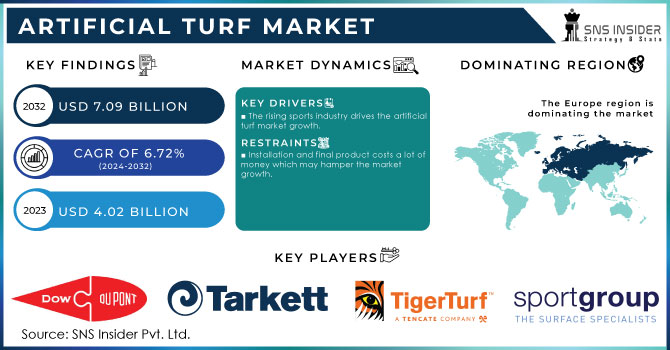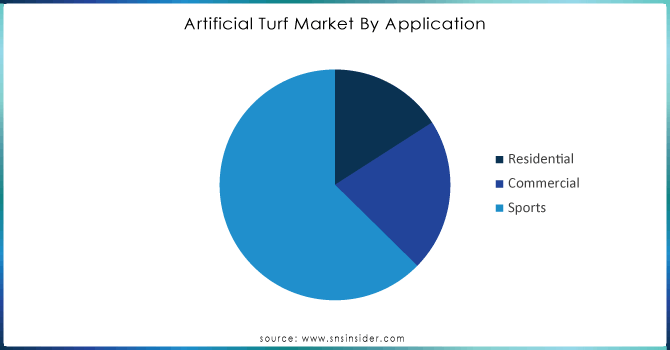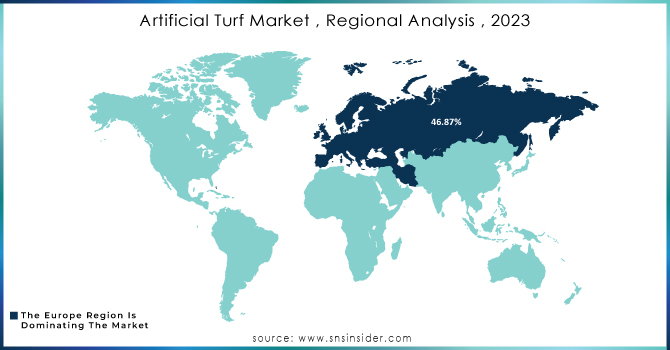Artificial Turf Market Report Scope & Overview:

Get More Information on Artificial Turf Market - Request Sample Report
The Artificial Turf Market Size was valued at USD 4.02 billion in 2023 and is expected to reach USD 7.09 billion by 2032 and grow at a CAGR of 6.72% over the forecast period 2024-2032.
The increasing popularity of artificial turf in sports fields and playgrounds can be attributed to its strong resistance and long-lasting quality. Crafted to withstand significant foot traffic and harsh weather conditions, contemporary synthetic turf can last some years. This durability makes it a money-saving choice for extended use, decreasing the necessity for frequent replacements.
According to the U.S. Environmental Protection Agency data shows that artificial turf decreases the necessity of lawn chemicals, consequently reducing the environmental footprint during its lifetime. Furthermore, the EPA points out that using fake grass in public areas helps achieve notable water conservation, especially in areas susceptible to drought.
Moreover, the increasing demand for artificial turf is largely due to its contribution to water conservation, particularly in dry regions or places with limited water resources. Artificial turf eliminates the need for frequent watering, resulting in noteworthy water conservation compared to real grass. This environmental advantage is especially important in areas where saving water is a top concern.
In 2023, Tarkett Sports launched a new collection of synthetic turf known as "Ecocept," featuring recycled materials and reduced water usage during manufacturing. This advancement is in line with worldwide sustainability objectives and offers extra water-saving advantages when implemented.
Furthermore, contemporary synthetic grass is created to imitate natural grass in both appearance and texture, giving a green, lush look all year. The visual attractiveness of something increases the desire for it in residential landscaping and commercial uses.
Artificial Turf Market Dynamics:
Drivers
The rising sports industry drives the artificial turf market growth.
The rising popularity of sports like soccer, American football, and baseball has greatly increased the need for artificial turf, particularly in stadiums and training centers. Sports organizations prefer artificial turf because of its uniform surface quality, guaranteeing a consistent playing experience and lowering the chances of injuries from uneven ground. Moreover, artificial turf is extremely durable, and able to handle intense usage and various weather conditions, making it crucial for facilities that hold regular games and training sessions. It is a cost-effective option for sports facilities due to its low maintenance needs in comparison to natural grass. Artificial turf has become the preferred playing surface for numerous sports organizations worldwide due to a combination of factors and advancements in turf technology that improve player safety and performance.
For instance, in 2023, AstroTurf launched an updated model of its RootZone 3D3 system, merging innovative fiber technology with a patented infill layer. This advancement enhances impact cushioning and energy rebound, making it well-suited for American football and baseball fields. The system's increasing popularity is evident in its installation in many college and professional stadiums throughout the U.S.
Restrain
Installation and final product costs a lot of money which may hamper the market growth.
The significant obstacle to the widespread use of artificial turf is the high initial investment and ongoing maintenance expenses. The cost of installing artificial turf is significant, including payments for ground preparation, drainage setups, specific tools, and the turf material. Smaller sports facilities, schools, or residential projects with constrained budgets may find these expenses especially challenging. Moreover, despite the cost savings and reduced water usage that comes with artificial turf, some potential buyers are deterred by the initial high cost if they lack the necessary capital. Even following installation, there may be expenses linked to fixing, changing infill materials, and regular maintenance, increasing the total financial load. The high initial costs of artificial turf create a financial obstacle that prevents its wider adoption beyond those who can afford it, despite its numerous advantages.
Artificial Turf Market Segmentation
By Material
Polyethylene, materials held the largest market share market and held a share of around 43.45% in 2023. It dominates the artificial turf industry's market because of its excellent mix of strength, adaptability, and safety. Polyethylene fibers have high durability and are perfect for heavily used spaces such as sports fields and playgrounds. They provide a gentler, more organic sensation in contrast to materials like nylon, resulting in increased player satisfaction and decreased chances of abrasions from falling. Furthermore, the UV resistance of polyethylene guarantees that the artificial grass will retain its color and quality, even when exposed to sunlight for extended periods. Manufacturers and consumers both prefer polyethylene, making it the dominant choice in the artificial turf market due to these characteristics.
By Application
In the application segment sports segment held the largest market share around 62.63% in 2023. The growing interest in different sports, such as soccer, American football, and baseball, has led to a high demand for artificial turf in stadiums, training centers, and sports complexes. Sports organizations choose artificial turf over natural grass for its even playing surface, longevity, and reduced upkeep expenses. It is perfect for sports applications due to its durability and ability to withstand harsh weather conditions, ensuring a safe and reliable surface for athletes. The increasing popularity of professional and amateur sports leagues globally is driving the demand for artificial turf in the sports industry, making it the leading application segment in the market.

Get Customized Report as per your Business Requirement - Request For Customized Report
Artificial Turf Market Regional Analysis:
Europe held the largest market share in the artificial turf market about 46.87% in 2023. This dominance can be attributed to the well-developed industrial base, and the market for Artificial Turf thrives alongside domestic industrial growth. Specific sectors within North America are experiencing particularly explosive growth. The communication industry is a prime example. Fueled by continuous technological advancements and significant investments in communication infrastructure, this sector is driving a surge in demand for Artificial Turf.
Asia Pacific is the fastest-growing region in the artificial turf market. With the growth of urban areas, the need for low-maintenance and water-efficient options like artificial turf is increasing to improve public areas and commercial properties. Furthermore, the growing sports scene in the area, along with major funding for stadiums and sports facilities, continues to fuel the need for top-notch synthetic turf. Government actions supporting sustainable development and water conservation are also driving the growth of the Asia-Pacific artificial turf market, making it a dynamic and quickly expanding sector in the global industry.

Key Players
Dow dupont, Sport Group, Tigerturf, Matrix Turf, Tarkett, Shaw Industries, Victoria PLC, Controlled Products, ACT Globall, SIS Pitches, and other players.
Recent Development:
-
In 2024, Polytan launched the new Polytan LigaTurf collection, with a focus on eco-friendly materials and improved safety features for sports purposes. The company additionally made investments in modernizing its production plants in Germany to integrate new technologies and enhance manufacturing efficiency.
-
In 2023, Shaw Sports Turf introduced the Shaw Sports Turf Prestige series, which includes enhanced fiber technology for better durability and player comfort. The company invested in improving its manufacturing capacity in the U.S. and Asia to meet the growing global demand.
| Report Attributes | Details |
|---|---|
| Market Size in 2023 | US$ 4.02 Billion |
| Market Size by 2032 | US$ 7.09 Billion |
| CAGR | CAGR of 6.72% From 2024 to 2032 |
| Base Year | 2023 |
| Forecast Period | 2024-2032 |
| Historical Data | 2020-2022 |
| Report Scope & Coverage | Market Size, Segments Analysis, Competitive Landscape, Regional Analysis, DROC & SWOT Analysis, Forecast Outlook |
| Key Segments | • By Material (Polyamides, Polypropylene, Polyethylene, Nylon, Sand Plant Infill Material) • By Application (Residential, Commercial, Sports) |
| Regional Analysis/Coverage | North America (USA, Canada, Mexico), Europe (Germany, UK, France, Italy, Spain, Netherlands, Rest of Europe), Asia-Pacific (Japan, South Korea, China, India, Australia, Rest of Asia-Pacific), The Middle East & Africa (Israel, UAE, South Africa, Rest of Middle East & Africa), Latin America (Brazil, Argentina, Rest of Latin America) |
| Company Profiles | Dow dupont, Sport Group, Tigerturf, Matrix Turf, Tarkett, Shaw Industries, Victoria PLC, Controlled Products, ACT Globall, SIS Pitches, and other players. |
| Drivers | • The rising sports industry drives the artifical turf market growth. |
| Restraints | • Installation and final product costs a lot of money which may hamper the market growth. |

